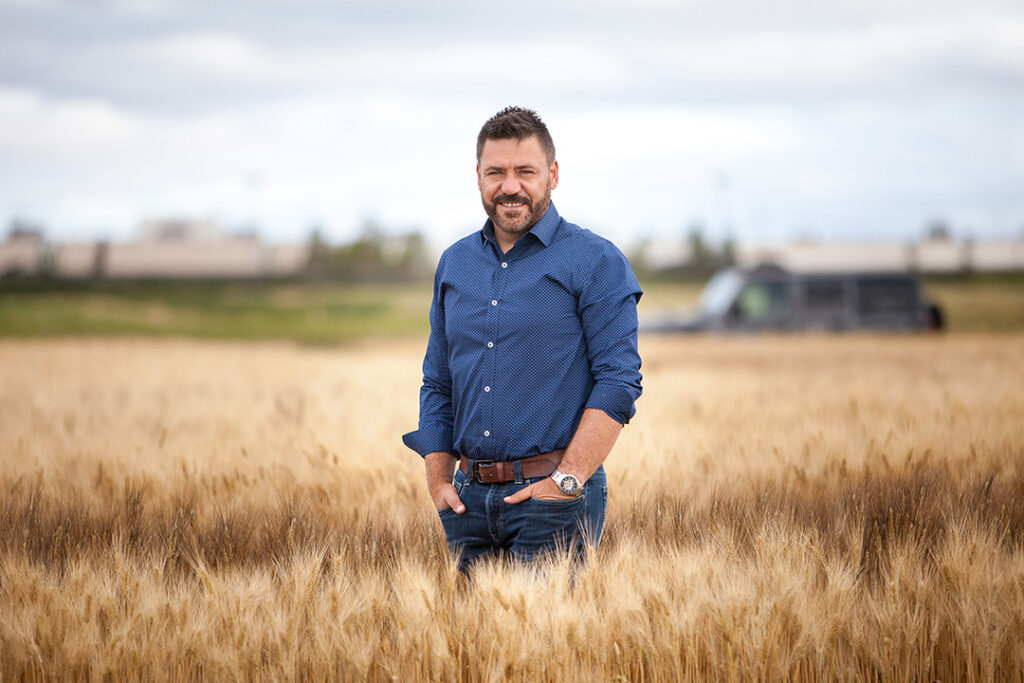In a brave new world dominated by technology, time-honoured breeding techniques are what still drive plant science — and the Prairie Grain Development Committee — forward.
The 2024 meeting of the Prairie Grain Development Committee (PGDC) enjoyed a sold-out crowd this year as over 300 people gathered in Saskatoon, Sask. for the annual event.
PGDC is responsible for coordinating research and development activities related to grain crops in Western Canada, which includes conducting research on grain production, processing, and marketing, as well as developing new grain varieties and improving existing ones. Every year it puts forward promising new lines to be registered as varieties by the federal government.
But as was made clear at this year’s plenary session, the tools that make for a game-changing new variety might increasingly come from the world of new breeding techniques (NBTs), one of them being gene editing.
“The extremes we’ve seen, not just in Western Canada but worldwide, have shown us the importance of ensuring steady crop production year after year. This means not only boosting yields but also safeguarding against issues like drought and disease that accompany unpredictable weather,” said Norm Sissons, senior vice-president seed & traits for Cibus. The company focuses on accelerating trait development across crops using tools like gene editing.
“We believe gene editing can play a crucial role in addressing these challenges. Traditional GMO breeding methods are costly and time-consuming, limiting innovation to a few big players. However, gene editing offers a more cost-effective and precise approach, with the potential to democratize the technology and involve more participants in crop improvement.”
Cibus’ approach involves using various gene editing technologies, including CRISPR, to modify crops efficiently and precisely. By focusing on single-cell editing and utilizing templates for mutagenesis, Sissons said the company aims to streamline the process and make it more accessible.
“Our goal is to develop high-throughput gene editing techniques that can efficiently tackle complex traits in crops. By automating and optimizing the editing process from start to finish, we aim to speed up trait development and make it more cost-effective.”
Currently, the Cibus pipeline focuses on traits like pod shatter reduction in canola and herbicide tolerance in rice, with plans to expand to other traits and crops in the future. Additionally, Sissons sees opportunities for collaboration and new business models in the gene editing space.
“Canada, the EU, and the U.S. are making progress in establishing clear regulatory guidelines, which will pave the way for widespread adoption of gene-edited crops,” he said.
“We’re at the forefront of a transformative moment in agriculture, where gene editing has the potential to revolutionize crop production and address the challenges posed by climate change.”

NBTs Going Public
That potential is by no means the sole purview of the private sector, of course. Curtis Pozniak, director of the Crop Development Centre in Saskatoon, said while the fundamental principles have remained consistent over the past two centuries, the technologies we employ and how we apply them have undergone significant transformations.
He pointed out that it’s essential to understand that no single technology holds all the solutions on its own. Instead, it’s the synergy and integration of various tools within the broader context of breeding programs that yield significant results. In that vein, his wheat breeding program’s toolbox comprises a multitude of modern elements, from germplasm selection to field-based phenotyping, from biotechnology to data analytics.
“To expedite our breeding programs, reducing generation time is paramount. Techniques like double haploid technology and controlled environment growth chambers allow for accelerated breeding cycles, significantly shortening the time to release new varieties,” he said.
For Pozniak, marker-assisted selection (MAS) has been a workhorse in predictive breeding, allowing his team to identify and select for specific genes linked to desired traits. Over the years, DNA marker technologies have evolved from low-throughput to high-throughput platforms, enabling more comprehensive genome-wide analyses.
“The advent of next-generation sequencing has further revolutionized our understanding of crop genomes. By sequencing thousands of genomes, we can pinpoint genes associated with key agronomic traits, facilitating marker development and genomic selection,” he added.
Moving beyond individual genes, whole-genome approaches like genomic selection have gained traction.
“By training predictive models with genotype-phenotype data, we can estimate breeding values for complex traits, optimizing selection efficiency.”
That means faster breeding, and varieties likely coming to market faster in the future. That will bring change for an organization like PGDC.
Ch-ch-ch-changes
Sheri Strydhorst, outgoing chair of PGDC, said she believes changes are ahead for PGDC over the next few years. For Strydhorst, emerging breeding tools and regulatory initiatives like Seed Regulatory Modernization are going to significantly alter the breeding landscape within which PGDC operates.
“This group will have to remain adaptable and flexible, as it has done throughout history. We’ve continually evolved and refined our methods to better serve the needs of the industry,” she said.
Dana Maxwell, chair of the Prairie Recommending Committee for Wheat, Rye and Triticale (PRCWRT), notes that such adaptation has resulted in the efficient form PGDC is taking in current incarnation.
“What I’m particularly proud of this year is the progress we’ve made in modernizing our processes and implementing initiatives that we began as far back as 2020 with the common Hard Red Spring wheat checks. These efforts are beginning to show significant results and are aligning well with other activities aimed at furthering our modernization efforts,” she said.
“This builds upon the groundwork laid by initiatives such as the removal of kernel visual distinguishability as a selection criterion, a change that was implemented even before I joined the committee. It’s rewarding to see how these efforts are coming together to shape a more efficient and effective system.”
This year, the PRCWRT approved 20 lines for recommendation: 12 CWRS, 2 CPSR, 2 durum, 2 fall rye, 1 spring triticale and 1 forage wheat. Maxwell is excited about the opportunity that lies ahead for these crops.
“It ultimately falls on individual developers and organizations to determine which traits are worth pursuing, but I see numerous complex challenges that we face, challenges that gene editing, under the right regulatory environment and support, could potentially address. With the right strategy in place to gain market support, I truly believe gene editing could be instrumental,” she said.
“When I put on my producer hat and consider the possibilities, I see opportunities to enhance sustainability by making yields more resilient and reducing the impact of diseases and pests. [AAFC Swift Current wheat breeder] Richard Cuthbert’s discussion about the difficulty of achieving both CWRS quality and the solid stem trait really hit home with me,” she adds.
“It’s a demanding breeding objective. He’s managed to develop a promising line, but it’s taken significant effort to maintain that quality level. Tools like gene editing offer the potential to streamline this process and alleviate some of the yield drag associated with integrating various traits into the material.”
BW5104 – a new solid stem wheat 🌾 line with CWRS type quality proposed for registration at #PGDC2024 Stands up to wheat stem sawfly. Very fast development utilizing technologies – doubled haploid, 🧬 markers. Farmer focused @wheat_research @AAFC_Canada pic.twitter.com/yPITbwRWj6
— Richard Cuthbert (@wheat_dr) February 29, 2024
NBTs: Curb Your Enthusiasm?
Such innovative lines are forging a brave new future for cereals and pulses. Limagrain Cereals Research Canada (LCRC) put forth numerous wheat lines this year for consideration. Wheat breeder Andy Chen notes that LCRC is one of the very few private breeding programs still active in Canada, and he says it has some unique advantages.
“Being part of a larger international entity like Limagrain also grants us access to resources on a global scale. With breeding programs in Spain and South America, we can tap into diverse germplasm from various regions, which is crucial for enhancing genetic diversity in our breeding efforts. This enables us to bring in superior germplasm suited to Canadian growing conditions,” he said.
“Being part of a larger company also provides us with the capacity for advanced genotyping. Genomic selection, a groundbreaking tool in modern breeding, allows us to predict the performance of lines in the field based solely on DNA data. This enables us to make more informed decisions in the early stages of breeding, ultimately translating into value for farmers more efficiently.”
He says that while LCRC currently holds an advantage in access to such technologies, other breeding programs — especially those in the public sphere — are increasingly venturing into NBTs, essentially creating a playing field that is rapidly becoming more crowded.
While there is much to get excited about when it comes to NBTs, the time-tested principles of plant breeding remain one of the most powerful tools to move Canadian agriculture forward, noted DL Seeds seed production manager and pulse breeder Glen Hawkins. He’s chair of the Prairie Recommending Committee for Pulses & Special Crops (PRCPSC). The committee approved 18 lines for recommendation this year — 3 dry bean, 7 field pea, 5 lentil, 1 specialty lentil and 2 faba bean lines.
“As breeders we all look for yield and protein and things that create value for farmers. And as we push further down the road, there is some chatter now about quality, be it protein quality or starch quality. It’s nothing that’s in the mainstream breeding programs at the moment, but people are beginning to ask those questions,” he said.
“That said, the protein market in Canada is basically flatlined. It hasn’t necessarily collapsed, but it’s not as quite as vigorous as it was a few years ago. So, it really comes down to the fundamentals of agronomy. Our primary aim is to provide Canadian farmers with top-notch varieties they can trust and rely on. Whether it’s a high-protein line, a high-yielding one, or a blend of both attributes, the goal remains the same: to deliver lines that farmers can confidently plant in their fields and generate profit from.”
As a result, he says that while gene editing holds much promise, it’s only as good as what it’s able to do for farmers.
“The effectiveness of gene editing ultimately hinges on the phenotypic outcomes it produces. It’s about being able to measure or observe the changes brought about by gene editing. That’s why all the discussions around gene editing today pay tribute to traditional plant breeding methods,” Hawkins added.
“That foundational aspect isn’t going anywhere. Gene editing simply adds another tool to the breeder’s toolbox, helping to expedite the breeding process or address bottlenecks along the way. Gene editing holds the promise of potentially achieving in a few years what has eluded us for decades in traditional breeding methods.”
Stay tuned for exact numbers of the lines approved by the Prairie Recommending Committee for Oats and Barley for recommendation this week.













